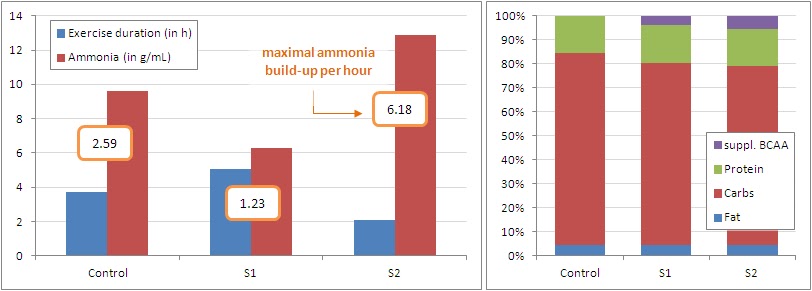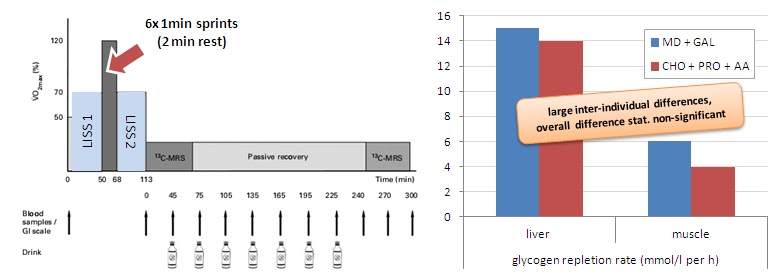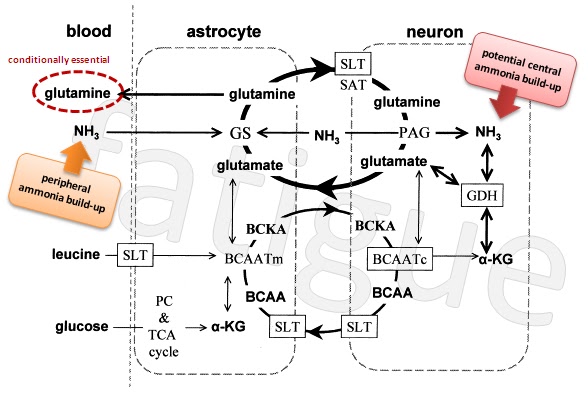L-Glutamine: Better Than Leucine? Posted on 10 Apr 20:57 , 0 comments
By Todd Lee M.D.
Who am I? Click here for my Bio!
NEED HELP? GET A PHONE CONSULTATION OR COACHING!
Glutamine
Everyone has heard that Glutamine and the Branch Chain Amino Acids are very important for muscle building in general but it’s confusing to understand where the L- glutamine benefits differentiate from the BCAA benefits.
Some commonly held beliefs about our friends:
- Glutamine is very important, one of the big 5 amino acids
- Glutamine is used by the immune system, it’s a great idea to take if you're exposed to harsh weather after a workout or you're around a lot of germs
- Glutamine is supposed to make up 50% of skeletal muscle and is a very important fuel source just like leucine once carbs run out
- Leucine is magical; it is made from unicorn blood and can do amazing things
- Leucine in the right amount every 2 hours causes a anabolic trigger which initiates muscle growth
- Leucine replaces the need for carbohydrates
- Leucine causes direct stimulation of the mTOR pathway, an important second messenger to DNA transcription
- Leucine causes insulin to be released indirectly helping “load” muscles with carbs and aminos
- Isoleucine is better at SENSITIZING the cell to carbs and aminos WITHOUT the need or release of Insulin
- Isoleucine does the anabolic stuff of Leucine but not as well
- Isoleucine blunts the insulin release of Leucine but Leucine blunts the effects of Isoleucine
- Valine is inferior to leucine and Isoleucine but doesn’t have much insulin release
Everyone has these three BCAAs sold together but that’s nonsense since they do opposing things... and valine sucks.
For more on the Branch Chain Amino Acids read my masterpiece here!
I’m going to try to highlight some important findings. by tieing together unrelated experiments I'm going to draw some conclusions. This is what we call “interpreting data.” You're about to see that leucine does not live up to the hype. L-Glutamine does.
To much BCAA can be bad
A study was done on 3 groups of rats: control, S1 and S2.
S1 got 50% more amino acids than the control had in their normal rat chow. S2 got 100% more amino acids than the control. In other words S2 only received double the amount of amino acids as the control.
The rats had a weight tied to their tails and forced to swim until they were exhausted. As the graph shows the S1 group metabolized less amino acids and subsequently had less ammonia in the blood the than the S2 group which one would expect would perform better! Thats what leucine is supposed to do right? Replace the need for carbs? This resulted in MORE ENDURANCE FOR THE LESSER TREATED GROUP! That means when it comes to bcaa and endurance, a little is good, a little more is overkill.

On left it shows that the Blue (good) is higher with the S1 or LESSER TREATED group. And the Red (bad; Ammonia) is MUCH higher with the S2 or MORE BCAA group. The tiny difference in blue at the top of the second graph is how much more BCAA that S2 got over S1
Simple Version
Branch chains in the right amount provide and increase to endurance and a decrease to ammonia in the blood but in to high a level cause a decrease in endurance due to an increase of ammonia in the blood. These results were independent of tryptophan, serotonin, and melatonin as those levels did not change. Those were previously believed to be the reason for the fatigue induced by ammonia.
Now the ratio of Glutamine to Leucine was piss poor and this could have caused inhibition of gluconeogenesis; the formation (-genisis) of new (-neo-) glucose (gluco-). With more carbs in the diet gluconeogenesis wouldn't be necessary to the same extent. Thus, to stave off the loss of endurance from slightly increased BCAA one would need more carbs or glutamine. Having more carbs you wouldn't be using the BCAAs for fuel, you would be using carbs, and if you had more glutamine but not carbs the glutamine would stimulate gluconeogenesis as I detail later. ( Czarnowski. 1995; Snow. 2000; Carvalho-Peixoto. 2007).
Leucine Post Workout Can Impede Glycogen Synthesis
In this study cyclists were instructed to cycle for 45 minutes, then do 6 intervals for 60 seconds with a 2 min rest, then 45 more minutes of steady state cycling. Two groups were tested, A and B. Group A consumed a solution of either a galactose and maltodextrin (CHO), Group B received CHO + Leucine and phenylalanine.
 As you can see the carbohydrate only group A (CHO) has 150% the glycogen synthesized as the leucine + CHO group B. This would seem to indicate that the increase of insulin that is released from the leucine causes the insulin to divert carbs which would normally have went to the muscle for glycogen synthesis actually went to the fat cells for storage. In other words, adding leucine did not help glycogen synthesis, it hindered it, AND it caused the carbs to go somewhere else (probably fat storage).
As you can see the carbohydrate only group A (CHO) has 150% the glycogen synthesized as the leucine + CHO group B. This would seem to indicate that the increase of insulin that is released from the leucine causes the insulin to divert carbs which would normally have went to the muscle for glycogen synthesis actually went to the fat cells for storage. In other words, adding leucine did not help glycogen synthesis, it hindered it, AND it caused the carbs to go somewhere else (probably fat storage).
Insulin is a double edged sword which in this case only hurt. Thanks Leucine, you suck!
Glutamine for Hypoglycemia?
In a recent study done in brazil on glutamine mitigating the effects of hypoglycemia. It seems glutamine works better than glucose at restoring blood sugar. (Nunes Santiago. 2013).

Lets say you need to have a blood glucose concentration of 70 mg/dl to be a happy camper. With glutamine the blood sugar reached a ‘normal’ level at 180 minutes after insulin injection. With alanine it was 70 mg/dl at 240. But saline and glucose had the same effect as each other, NOTHING!
It's postulated that the difference is that alanine and glutamine are gluconeogenic: they start gluconeogenesis. A study in japan showed that 8 g of glutamine was equivalent to 28 g of dextrose (8.5% dextrose solution in 330 ml water thus obeying the 8% solute: 92% solvent law)
This would imply that either 1 gram of glutamine generates 3 g of dextrose (as thats thermodynamically impossible; matter can neither be created or destroyed) or more likely that the glutamine stimulated gluconeogenesis. Gluconeogenesis to the tune of 300% of actual blood sugar!
Ammonia
There has been research going back over 30 years showing ammonia is present in the blood along with lactate with even 40% Vo2 max effort (not much at all).
Unlike lactate which rose slowly and continued to rise after exercise (fuel metabolite of carbohydrate metabolism in the glycolysis pathway) ammonia levels rose rapidly during exhaustive effort and diminished rapidly afterward.
This indicates that ammonia is the main toxin for perceived exhaustion during training. Ammonia is the byproduct of using protein for fuel in gluconeogenesis. When the levels in the blood get high it crosses the blood brain barrier and symptoms of exhaustion such as lack of coordination and confusion set in.

Another study was done (Nybo, Lars, et al 2005) in which 2 groups performed, you guessed it, cycling! One group pedaled their little hearts out for 3 hours and saw an increase of ammonia in the brain over that period of exercise. From 2 to 16 units. In another group, the cyclists drank maltodextrin in water totalling 15 g carbs every 15 minutes for 180 g carbs in 3 hours of cycling. Their ammonia only went from 2 to 5 units in their brain. Not surprisingly the group with the ammonia level 3 times higher felt more tired, but not 3 times more tired!
Looks like drinking 60 g glucose during a 60 minute workout can stop some ammonia accumulation and decreases the perception of effort during training…. Exactly what the larger amount of BCAAs didn’t do. Hey Leucine, YOU SUCK!
Glutamine and Ammonia
This study (Bassini 2008) tested football players for ammonia accumulation after 100 mg/kg of glutamine or alanine for intermittent training, and glutamine vs placebo for continuous training. A measurement called SEM% was used to determine amount of ammonia. Lower number means less ammonia. The best group was the intermittent training with glutamine (SEM 13%) the worst was continuous training without glutamine (SEM 99%). Continuous training with Glutamine was SEM 44%.
If we extrapolate this data we can see two things: Using Glutamine at 10 g / 100 kg (220 lb guy) will help with ammonia in weight training (intermittent SEM: 13%) but much more with cardio (continuous: SEM 44% instead of 99% without!)
When you look at the other studies this kind of makes sense. Clearly cardio is different on exhaustion than weights, and the other studies were on cyclists and swimming rats (cardio and cardio). Seems that although ammonia in the brain accumulation from lifting will be mitigated by glutamine it’s not as impressive an effect as other studies would indicate. It is however, a profound effect when compared to alanine (13% instead of 37%, a 3 fold difference). One could imagine if Alanine was almost as good as glutamine in the other study, and light years better than saline (nothing) than the SEM % would be MUCH higher than 37% without either glutamine or alanine.
Glutamine Toxicity?
The maximum tested amount of glutamine is 0.65 g /kg for 14 days with no ill effects. Thats like 50 g a day for 14 days no problem, and levels over 20 g a day have also been tested with no ill effects. (Gleeson 2008)
Verdict
This means for me, at 80 kg I will start adding 8 g of glutamine to my pre or mid workout drinks to prevent ammonia accumulation and fatigue, as well as not burning my muscle while training. Since I use arginine pre workout (ingredient in Fenris' Fury) I can either save my glutamine for mid workout, or if i take it with arginine I have to take 50% more since the two amino acids compete for absorption. Likewise I would add more citrulline and arginine as well.
And as far as the glycogen synthesis I don’t see what the upper limit is regarding effectiveness of glutamine but the same amount (100 mg/KG in my case 8 g) was what was used to prove superior to 8 g glucose/dextrose. The ideal amount was found to be 0.8g dextrose/ kg + 0.4 g fructose/ Kg. Thats 64 grams dextrose, 32 g fructose for me: 2 bannanas and 4 rice cakes or ¾ cup Crasins. If one was to use ToddLeeMD.com Mid Workout (my new mid workout drink, Availiable 2016) the carbs post workout would be much more likely to turn to muscle than fat.
For Leucine, I am not using more than a small amount mid workout if at all. Isoleucine helps load carbs into the muscle cell and insulin hurts this, so mid workout and pre workout Isoleucine makes sense and leucine does not.
That's why I put Isoleucine and n0t leucine in Battle Mead Intra. The Isoleucine loads the carbs already in the blood into the muscle cell mid workout. Additional carbs mid workout would be great but they would cause some insulin release. That’s why I didn't use normal carbs in Battle Mead Intra, I used a 2:1 Glycerol:Dextrose ratio.
Glycerol is half a carb; the pancreas is fooled into not seeing it, and with Isoleucine and other ingredients in Battle Mead Intra help these half carb molecules are loaded into the cell and used to create a pump and be used as fuel, so you can have a pump and energy but not stop fat burning from the Thor's Hammer and Fenris' Fury.
Disclaimer
Nothing in this article or on this site should be considered medical advice or as an endorsement to violate any law of the country in which you reside. The information given is for fun and entertainment purposes only. All claims are 100% dependent upon proper diet and exercise. Please consult a medical practitioner prior to any diet and exercise program.
References
Falavigna G, de Araú jo Junior JA, Rogero MM, de Oliveira Pires IS, rio Graç a Pedrosa R, Martins Junior E, Alves de Castro I, Tirapegui J. Effects of Diets Supplemented with Branched-Chain Amino Acids on the Performance and Fatigue Mechanisms of Rats Submitted to Prolonged Physical Exercise. Nutrients 2012. 4; 1767-1780.
Banister, E. W., et al. "The time course of ammonia and lactate accumulation in blood during bicycle exercise." European Journal of Applied Physiology and Occupational Physiology 51.2 (1983): 195-202.
Bassini-Cameron, Adriana, et al. "Glutamine protects against increases in blood ammonia in football players in an exercise intensity-dependent way." British journal of sports medicine 42.4 (2008): 260-266.
Nybo, Lars, et al. "Cerebral ammonia uptake and accumulation during prolonged exercise in humans." The Journal of physiology 563.1 (2005): 285-290.
Takeda, Kohei, et al. "Effects of citrulline supplementation on fatigue and exercise performance in mice." Journal of nutritional science and vitaminology 57.3 (2011): 246-250.
http://suppversity.blogspot.com/2012/11/chronic-high-dose-bcaa-supplementation.html

